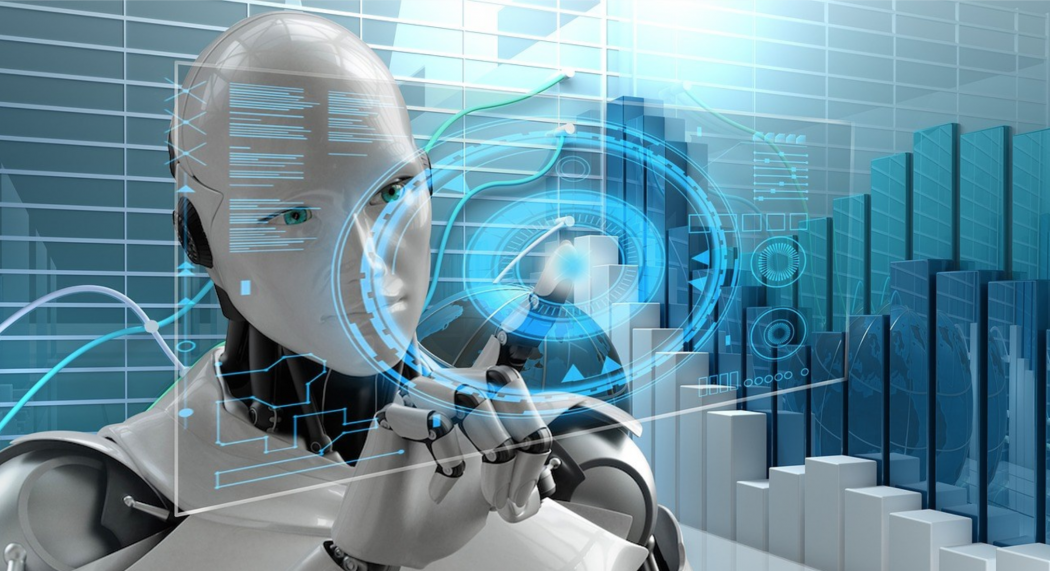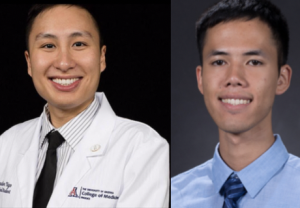Are machines going to take over medicine? This might be a question you have heard or asked yourself, especially after watching movies demonstrating somewhat unsettling, yet realistic portrayals, of artificial intelligence (AI). Films such as Ex Machina, Her, or I, Robot might have instilled uncertainty or even fear surrounding the topic of AI. Although these theatrical representations of AI seem to paint machines as threatening and invasive, we are writing to provide an introduction to AI and its potential applications in medicine, and alleviate anxiety regarding the subject. As future physicians, we must be cautiously optimistic in our approach to AI, but to do that, first we must be informed.
The medical landscape is undergoing monumental changes, as the wealth of medical knowledge grows and technology advances. In 1950, the doubling time for medical knowledge was 50 years; just next year, in 2020, the doubling time will be reduced to a mere 73 days [1]. AI has the potential to help us organize, synthesize, and analyze the constantly expanding body of medical information [2]. Furthermore, AI will become an important colleague in our mission to best serve our diverse patients by providing high accuracy diagnostic and treatment recommendations that take into consideration unique patient characteristics [3][4]. Clinical workflow also can be optimized, with AI reducing time spent on laborious tasks, like never-ending charting [5]. Less time spent on writing notes and filling out paperwork and more time spent with patients? Sign us up!
Below, we provide a glossary of relevant terms, some examples of applied AI, and a brief snapshot of AI’s current capabilities and impact on the medical field.
Glossary of Relevant Terms for AI
Artificial Intelligence (AI): A multi-disciplinary field aimed at simulating human intelligence by machines.
Machine Learning (ML): An application of AI in which machines are able to learn without being explicitly programmed to do so. Also, defined as a set of statistical methods that enable machines to improve with experience.
Deep Learning (DL): A subset of ML that uses multi-layer computation in the form of artificial neural networks (ANNs). Deep learning methods can be classified as “supervised learning” or “unsupervised learning”.
Artificial Neural Network (ANN): Inspired by the human brain, a computational model that consists of layers of neurons: input layer (data provided), hidden layer (the function or complex analysis being performed on the input data), and the output layer (desired output produced).
Supervised Learning: When the machine analyzes a dataset with an answer key. The human supervisor provides a training data set that the machine can train on, and learn from, to update its computational model.
Unsupervised Learning: When the machine analyzes a dataset without an answer key. The machine will provide any inherent data structure that it finds.
Examples
The following are hypothetical examples meant to illustrate ANNs, trained with supervised and unsupervised learning:
ANN trained with “supervised learning” applied to radiology:
Question: Does the chest x-ray display a malignant mass?
Training: Numerous chest x-rays are fed into the input layer, then are processed in the hidden layer to determine the absence or presence and nature of a mass, and then the output layer might report malignancy, benign mass, or normal chest x-ray findings. For this type of training, the physician must give the ANN a series of chest x-rays that are clearly labeled as “malignant mass”, “benign mass”, or “normal chest x-ray”, so the ANN can check its accuracy, learn, and make necessary adjustments to its mathematical functions.
Application: The ANN now can make predictions about new incoming chest x-rays it has never encountered before, based on its previous training with a fully labeled data set.
ANN trained with “unsupervised learning” applied to cancer genomics:
Question: What gene clusters are related to the development of various solid tumors?
Training: Genetic data from numerous solid tumor cancer types are sent to the input layer, then are processed in the hidden layer by pattern-seeking algorithms, with the output layer displaying a modified version of the original data that has highlighted previously unknown connections between certain cancer genes.
Application: This type of ANN can find patterns within complex cancer genomics that we cannot otherwise discern. This application can provide further insights into cancer pathophysiology and potential avenues for cure. ANN trained with unsupervised learning is still in its infancy, but could have profound applications in numerous aspects of medicine, such as genetics and precision medicine.
Is AI Taking Over?
In 2016, 18-time world champion Go (chess board game) player Lee Sedol lost to Google’s AI program AlphaGo in a best-of-five match. In 2017, Xiaoyi, a Chinese AI program, took the national medical licensing exam and passed with 96 points above the passing grade [6]. In recent decades, there has been a marked rise in AI articles across numerous specialties, with the top three being oncology, neurology/neurosurgery, and cardiovascular [7]. With all these new studies coming out purporting the ability of AI to perform as well as humans, the fear of physicians being replaced is being brought up constantly, both in literature and anecdotally [8]. For example, will radiologists be replaced by AI? As one radiology expert, Dr. Elliott Fishman from Johns Hopkins University, stated, “Way back when, pathologists looked at every pap smear. Now a machine looks at them and once in a while it kicks something out. Things change” [9].
Contrary to anecdotal evidence, radiologists view AI favorably [10], and rightfully so, as they are recognizing the emerging technology and are adapting to provide the best care possible to patients. Currently there is more AI research than AI applications in actual clinical practice, for the right reasons. In addition to validating the accuracy of machines, there are a multitude of obstacles to overcome: deciding which tasks to assign independently to AI; how to pick one AI company over another; budgeting hospital costs to fund AI technology [11]. AI will be valuable to solve defined complex logical tasks, but it is less likely, or impossible, that it will substitute for the softer side of medicine that human physicians provide—ethics, patient-physician interaction, and interdisciplinary communication.
Conclusion
There is a period of unease whenever technology reaches another milestone. AI is that next milestone, especially for healthcare with its ever-growing amount of data. Advancements in AI are made continuously, both in the research and corporate worlds, and inevitably will affect medicine. It is imperative that we medical students and physicians adapt to this new resource and foster its proper implementation into the clinical world. Patients will likely ask about AI soon, so it is in our best interest to be prepared for their concerns. We hope that you see AI not as a villain waiting to happen, but as a future ally in medical practice.
Everyone has a role in welcoming this new change. Scientists and engineers can continue to improve the accuracy of these machines. Medical students can seek out AI medicine research and promote discussions about AI with peers and medical professionals, as well as to bring AI information into clinical teams. Physicians can stay up to date on the latest progress in AI. While AI will have a definitive impact on the future of medical care, there is one crucial aspect that AI cannot replace—the physician-patient relationship. We encourage peers to keep this sacred relationship at the heart of their practice, especially as the medical world continues to change with AI.
Special Thanks:
The authors are pleased to acknowledge Interventional Radiologist Dr. Eric vanSonnennberg, who provided clinical feedback and reviewed the manuscript.
- Densen P. Challenges and opportunities facing medical education. Trans Am Clin Climatol Assoc. 2011;122:48–58.
- Wartman SA, Combs CD. Medical Education must move from the information age to the age of artificial intelligence. Academic Medicine. 2018. 93(8), 1107-1109.
- Chen JH, Asch SM. Machine learning and prediction in medicine—beyond the peak of inflated expectations. NEJM. 2017;376(26):2507-2509.
- Char DS, Shah NH, Magnus D. Implementing machine learning in health care—Addressing ethical challenges. NEJM. 2018;378(11):981-983.
- Rajkomar A, Dean J, Kohane I. Machine learning in medicine. N Engl J Med. 2019. 380(14), 1347-1358
- Pakdemirli E. Artificial intelligence in radiology: friend or foe? Where are we now and where are we heading? Acta Radiologica open. 2019;8:2058460119830222.
- Galimova RM, Buzaev IV, Ramilevich KA, Yuldybaev LK, Shaykhulova AF. Artificial intelligence—developments in medicine in the last two years. Chronic Diseases and Translational Medicine. 2019;5:64-68.
- Noorbakhsh-Sabet N, Zand R, Zhang Y, Abedi V. Artificial intelligence transforms the future of health care. Am J Med 2019;132:795-801.
- Budd K. Will artificial intelligence replace doctors? AAMC News & Insights. 2019.
- Oh S, Kim JH, Choi SW, Lee HJ, Hong J, Kwon SH. Physician confidence in artificial intelligence: an online mobile survey. J Med Internet Res. 2019;21:e12422.
- Lau AYS, Staccini P. Artificial intelligence in health: new opportunities, challenges, and practical implications. Yearbook of Medical Informatics. 2019;28:174-178.
Brandon Ngo is a member of The University of Arizona College of Medicine – Phoenix, Class of 2022. He graduated from Duke University in 2017 and was involved with leukemia research prior to starting medical school. Brandon enjoys playing piano and spending time with his girlfriend.
Diep Nguyen is a member of The University of Arizona College of Medicine – Phoenix, Class of 2022. He graduated from UC Berkeley in 2017 and was involved with app development before medical school. Diep enjoys martial arts and cosplaying with his girlfriend.


